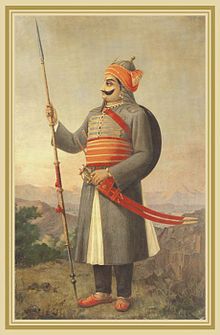| Maharana Pratap | |
|---|---|
| 13th Maharana of Mewar | |

Pratap Singh I in a painting by Raja Ravi Varma
| |
| Maharana of Mewar | |
| Reign | 1 March 1572 – 19 January 1597[1] |
| Predecessor | Udai Singh II |
| Successor | Amar Singh I |
| Ministers | Bhamashah |
| Born | 9 May 1540 Kumbhalgarh, Mewar[1][2] (Present day:Kumbhal Fort, Rajsamand District, Rajasthan, India) |
| Died | 19 January 1597 (aged 56)[1] Chavand, Mewar[1] (Present day:Chavand, Udaipur District, Rajasthan, India) |
| Spouse | Maharani Ajabde (consort) |
| Issue | Amar Singh I Bhagwan Das |
| Dynasty | Sisodia Rajput |
| Father | Udai Singh II |
| Mother | Maharani Jaiwanta Bai |
| Religion | Hinduism |
| Sisodia Rajputs of Mewar II (1326–1884) | |
|---|---|
| Hammir Singh | (1326–1364) |
| Kshetra Singh | (1364–1382) |
| Lakha Singh | (1382–1421) |
| Mokal Singh | (1421–1433) |
| Rana Kumbha | (1433–1468) |
| Udai Singh I | (1468–1473) |
| Rana Raimal | (1473–1508) |
| Rana Sanga | (1508–1527) |
| Ratan Singh II | (1528–1531) |
| Vikramaditya Singh | (1531–1536) |
| Vanvir Singh | (1536–1540) |
| Udai Singh II | (1540–1572) |
| Pratap Singh I | (1572–1597) |
| Amar Singh I | (1597–1620) |
| Karan Singh II | (1620–1628) |
| Jagat Singh I | (1628–1652) |
| Raj Singh I | (1652–1680) |
| Jai Singh | (1680–1698) |
| Amar Singh II | (1698–1710) |
| Sangram Singh II | (1710–1734) |
| Jagat Singh II | (1734–1751) |
| Pratap Singh II | (1751–1754) |
| Raj Singh II | (1754–1762) |
| Ari Singh II | (1762–1772) |
| Hamir Singh II | (1772–1778) |
| Bhim Singh | (1778–1828) |
| Jawan Singh | (1828–1838) |
| Sardar Singh | (1828–1842) |
| Swarup Singh | (1842–1861) |
| Shambhu Singh | (1861–1874) |
| Sajjan Singh | (1874–1884) |
| Fateh Singh | (1884–1930) |
| Bhupal Singh | (1930—1955) |
Battle of Haldighati
The bloody Siege of Chittorgarh in 1568 had led to the loss of the fertile eastern belt of Mewar to the Mughals. However, the rest of the wooded and hilly kingdom was still under the control of the Rana. The Mughal emperor Akbar was intent on securing a stable route to Gujarat through Mewar; when Pratap Singh was crowned king (Rana) in 1572, Akbar sent a number of envoys entreating the Rana to become a vassal like many other Rajput leaders in the region. When the Rana refused to personally submit to Akbar, war became inevitable.[8][9]The Battle of Haldighati was fought on 18 June 1576 between Maharana Pratap and Akbar's forces led by Man Singh I of Amer. The Mughals were victorious and inflicted significant casualties among the Mewaris but failed to capture Maharana.[10] The site of the battle was a narrow mountain pass at Haldighati near Gogunda, modern day Rajsamand in Rajasthan. Maharana Pratap fielded a force of around 3000 cavalry and 400 Bhil archers. The Mughals were led by Man Singh of Amber, who commanded an army numbering around 5000-10,000 men. After a fierce battle lasting more than six hours, Maharana found himself wounded and the day lost. The mughal were unable to capture him. He managed to escape to the hills and lived to fight another day.[11]
Haldighati was a futile victory for the Mughals, as they were unable to capture Maharana Pratap, or any of his close family members in Udaipur. As soon as the empire's focus shifted north-west, Pratap and his army came out of hiding and recaptured the western regions of his dominion.
Reconquest of Mewar
Mughal pressure on Mewar relaxed after 1579 following rebellions in Bengal and Bihar and Mirza Hakim's incursion into the Punjab. In 1582, Maharana Pratap attacked and occupied the Mughal post at Dewair (or Dawer). This led to the automatic liquidation of all 36 Mughal military outposts in Mewar. After this defeat, Akbar stopped his military campaigns against Mewar. The victory of Dewair was a crowning glory for Maharana Pratap, with James Tod describing it as the "Marathon of Mewar".[13][14] In 1585, Akbar moved to Lahore and remained there for the next twelve years watching the situation in the north-west. No major Mughal expedition was sent to Mewar during this period. Taking advantage of the situation, Pratap recovered Western Mewar including Kumbhalgarh, Udaipur and Gogunda. During this period, he also built a new capital, Chavand, near modern Dungarpu.Death and legacy
Reportedly, Pratap died of injuries sustained in a hunting accident[16] at Chavand[15]on 19 January 1597,[1] aged 56. He was succeeded by his eldest son, Amar Singh I.Historian Satish Chandra notes that
Rana Pratap's defiance of the mighty Mughal empire, almost alone and unaided by the other Rajput states, constitute a glorious saga of Rajput valour and the spirit of self sacrifice for cherished principles. Rana Pratap's methods of sporadic warfare was later elaborated further by Malik Ambar, the Deccani general, and by Shivaji Maharaj
No comments:
Post a Comment